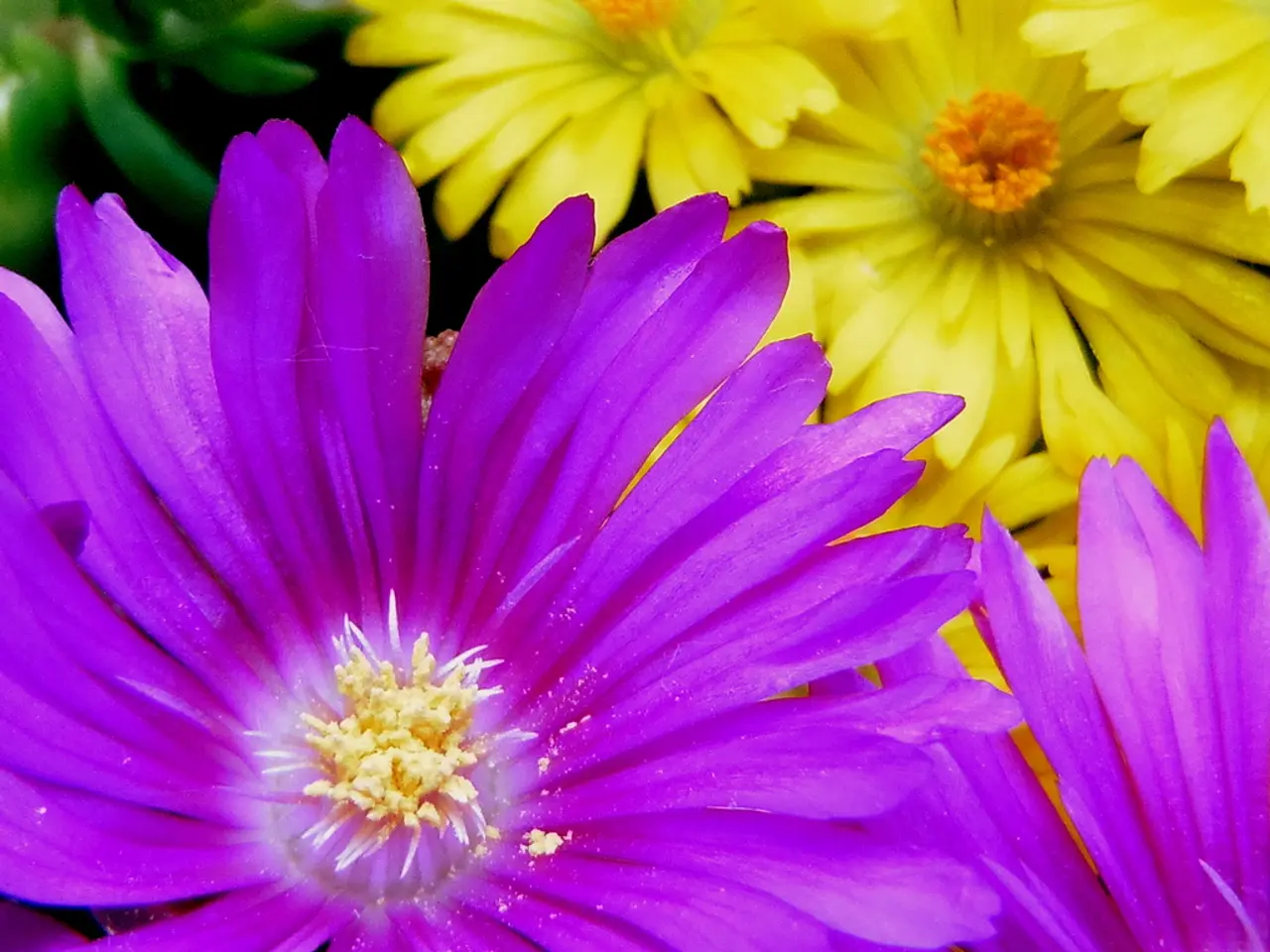Discover Tranquility in Your Garden with 11 Enchanting Annuals Sporting Blue Blooms
In the world of gardening, blue perennials are a delightful addition, offering a splash of colour and attracting various pollinators. Here's a guide to some of the most popular blue perennials, along with their ideal growing conditions.
Great Lobelia, with its showy lavender-blue flowers on stems 2-3 ft tall, thrives in consistently moist soil, often found near streams or rivers. Due to its tall stems, it may require staking for support.
Sea Holly (Eryngium planum) boasts striking steel-blue flowers that grow 2-3 ft tall and 1-2 ft wide. This hardy plant prefers full sun and prefers dry, sandy soil. It tolerates drought well and avoids overwatering to prevent root rot.
Siberian Bugloss (Brunnera macrophylla) is a low-growing perennial with delicate blue flowers and attractive foliage. It prefers partial shade, especially in hotter climates, and is easy to care for with few pests or diseases.
Blue Flax (Linum lewisii) is an airy plant with charming sky to powder blue flowers in spring. It prefers full sun and well-drained soils, is drought tolerant, and can reseed readily.
Blue Wood Aster (Symphyotrichum cordifolium) grows 2-5 ft tall with clusters of blue/purple flowers from August to October. It prefers partial shade and moist, well-drained soil.
Blue Veronica (Veronica spicata) offers tall spikes of blue flowers, growing 1-2 ft tall and 1-1.5 ft wide. It prefers full sun to partial shade and well-drained soil, and deadheading encourages longer bloom.
Baptisia is a tough perennial with blue flowers attractive to bumblebees. It prefers full sun and well-drained soils and is suitable for naturalistic gardens, as it is drought tolerant.
Eastern Bluestar blooms with blue, star-shaped flowers late spring through summer and forms clumps 3 ft tall and wide. It prefers full sun and well-drained soil.
Sky-blue sage, also called bog sage, tolerates poorly drained soil and prefers damp conditions. Love-in-a-mist grows best in average, moist, well-drained soil in full sun.
Floss Flower (Ageratum houstonianum) forms six-inch to foot-tall mounds of ovate to deltoid foliage and blooms all season long. The fluffy, aster-like flowers retain their colour for a long time, making the taller varieties good cut flowers. It appreciates rich, moist soil with good drainage in full sun.
Bush Violet (Browallia viscosa) grows in a bushy mound, with flowers in shades of blue with white centres and ovate leaves. It appreciates full sun with afternoon shade and rich, moist, well-drained soil.
Amazon Blue (Achetaria azurea), also called Brazilian snapdragon, has blue, two-petaled flowers that resemble snapdragons. It prefers full sun to part shade and moist, well-drained soil, and blooms midsummer into fall in most parts of the US.
Lobelia requires full to part sun and moist soil with good drainage. Lobelia (Lobelia erinus) offers a range of blue flowers in various cultivars, such as 'Cambridge Blue' and 'Blue Moon', and the flowers bloom multiple times if cut back.
Cineraria (Pericallis x hybrida) has daisy-like blooms that come in a range of bright colours, including blue, and often have a striking white ring around the centre. It likes moist, fertile soil with good drainage in partial shade.
Larkspur (Delphinium spp.) produces spikes of white to blue flowers from midspring to midsummer, with leaves that are palmately divided or lobed. It prefers moist, fertile, well-drained soil in full sun, with some afternoon shade in hot summers. Deadheading encourages a second, late-season flush of blooms.
Bachelor's buttons, also known as cornflower, grow well in full sun and appreciate moist, well-drained soil, but tolerate poor soils and dry conditions.
Love-in-a-mist (Nigella damascena) produces unique blue blooms with delicate bracts and pronounced stamens, and the attractive seed pods are suitable for dried bouquets.
Swan River Daisy (Brachyscome iberidifolia) has blue flowers and grows well in full sun and well-drained soil.
Dwarf Morning Glory (Evolvulus glomeratus) is a trailing plant that forms a carpet of small, fuzzy, oval leaves and blooms with brilliant blue flowers with white centres from early summer until frost.
Choosing the right blue perennial for your garden depends on your garden’s sunlight, soil type, and moisture availability. These versatile plants vary in light and water requirements, with some thriving in moist, partially shaded environments, while others do best in full sun with well-drained or dry soils. Most are hardy across a wide range of USDA zones, making them suitable for many regions.
- The Great Lobelia, with its lavender-blue flowers, thrives in consistently moist soil and may necessitate staking for support, making it ideal for gardens near streams or rivers.
- Sea Holly, a steel-blue flowered hardy plant, prefers full sun and dry, sandy soil, showcasing its 2-3 ft tall and 1-2 ft wide flowers.
- Siberian Bugloss, a low-growing perennial with delicate blue flowers and attractive foliage, prefers partial shade and is easy to care for in hotter climates.
- Blue Flax, with sky to powder blue flowers in spring, thrives in full sun and well-drained soils, reseeding readily to return year after year.
- The Eastern Bluestar blooms with blue, star-shaped flowers and forms clumps in full sun and well-drained soil, adding a delightful blue touch to the garden.
- Bush Violet, with its blue flowers and ovate leaves, appreciates full sun with afternoon shade and rich, moist, well-drained soil, perfect for incorporating blue tones in a home-and-garden project.




